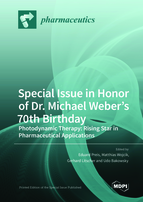Special Issue in Honor of Dr. Michael Weber’s 70th Birthday: Photodynamic Therapy: Rising Star in Pharmaceutical Applications
A special issue of Pharmaceutics (ISSN 1999-4923). This special issue belongs to the section "Clinical Pharmaceutics".
Deadline for manuscript submissions: closed (20 December 2021) | Viewed by 93471
Special Issue Editors
Interests: nanoscale drug delivery systems; photodynamic therapy; liposomes; gene therapy
Special Issues, Collections and Topics in MDPI journals
Interests: photodynamic therapy; drug delivery systems; nanoscale drug carriers
Interests: photodynamic therapy; antimicrobial therapy; nanofibers; polymeric nanoparticles
Special Issues, Collections and Topics in MDPI journals
Interests: photobiomodulation; laser therapy; laser acupuncture; laser medicine; evidence-based complementary medicine
Special Issues, Collections and Topics in MDPI journals
Special Issue Information
Dear Colleagues,
This commemorative Special Issue of Pharmaceutics is in honor of Dr. Michael Weber and his 70th birthday. Dr. Michael Weber is an internationally recognized medical practitioner and scientist in the field of photodynamic therapy and application of lasers.
Despite his work as a practicing doctor, Dr. Michael Weber has published many papers in the field of laser application. The laser devices invented and patented by Michael Weber have also been used by other scientists in many publications dealing with topical and interstitial photodynamic therapy. He is the founder of the International Society for Medical Laser Applications (ISLA) which combines the proficiencies of many honorable scientists all around the world. Dr. Weber has received different funding by the German government and the European Union for research development. He is also the host of three annual conferences (in Europe, Asia, and America) on the subject of photodynamic therapy and laser application.
He has pioneered the clinical use of lasers and photodynamic therapy for nearly 25 years in Germany and several other countries. Most recently, Dr. Weber’s research on the photodynamic killing of viruses and microorganisms, conducted in an international cooperation, successfully resulted in a published study using Riboflavin (Vitamin B2) and UV-light.
In honor and recognition of Dr. Michael Weber’s outstanding contributions to this field, this Special Issue welcomes the submission of original research manuscripts or reviews in the area of pharmaceutical sciences. We plan to receive submissions from now to July 20, 2021. Manuscripts will be published online on an ongoing basis after being processed.
Prof. Dr. Udo Bakowsky
Dr. Matthias Wojcik
Dr. Eduard Preis
Prof. Dr. Gerhard Litscher
Guest Editors
Manuscript Submission Information
Manuscripts should be submitted online at www.mdpi.com by registering and logging in to this website. Once you are registered, click here to go to the submission form. Manuscripts can be submitted until the deadline. All submissions that pass pre-check are peer-reviewed. Accepted papers will be published continuously in the journal (as soon as accepted) and will be listed together on the special issue website. Research articles, review articles as well as short communications are invited. For planned papers, a title and short abstract (about 100 words) can be sent to the Editorial Office for announcement on this website.
Submitted manuscripts should not have been published previously, nor be under consideration for publication elsewhere (except conference proceedings papers). All manuscripts are thoroughly refereed through a single-blind peer-review process. A guide for authors and other relevant information for submission of manuscripts is available on the Instructions for Authors page. Pharmaceutics is an international peer-reviewed open access monthly journal published by MDPI.
Please visit the Instructions for Authors page before submitting a manuscript. The Article Processing Charge (APC) for publication in this open access journal is 2900 CHF (Swiss Francs). Submitted papers should be well formatted and use good English. Authors may use MDPI's English editing service prior to publication or during author revisions.
Keywords
- photodynamic therapy and its application
- all applications of PDT, e.g.
- PDT in tumor therapy
- PDT in antimicrobial therapy
- PDT in combination with other types of therapy, e.g.
- classical chemotherapy
- antibiotics
- stem-cell therapy
- radiation therapy
- ultrasound applications
- photothermal therapy (PTT)
- physicochemical characterization of new carriers for PDT
- antimicrobial PDT for viral infections (including COVID-19)
- antimicrobial PDT and biofilms
- antimicrobial PDT for chronic wounds
- new photosensitizers and their effects
- clinical applications of PDT
- drug delivery systems
- new carrier systems for PDT, e.g.
- liposomes
- micelles
- nanoparticles
- fibers
- nanorods










